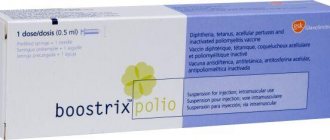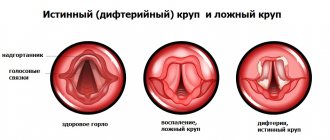Infanrix Hexa is an imported analogue of the domestic vaccine against diphtheria, whooping cough and tetanus. The uniqueness of this vaccine lies in the fact that, in addition to these three diseases, it also protects against polio, Haemophilus influenzae infection and hepatitis B. This is the most multicomponent vaccine of all DTP analogues (which also include Infanrix, Infanrix IPV and Pentaxim), the owner of a peculiar “ record" in 6 diseases to which it forms immunity. Moreover, each of these diseases is included in the National Vaccination Calendar for 2021.
Infanrix Hexa: pros
The main advantage of this vaccine is obvious: fewer injections means less stress that the child experiences. Another advantage for parents is that the risk of forgetting about any of the vaccinations is reduced to zero. It is important that all components are manufactured and combined into a vaccine with one reliable one - potentially such a vaccine is less reactogenic than a “cocktail” of different vaccines from different manufacturers, and often one multicomponent vaccine is also cheaper.
Contrary to popular belief, in terms of the frequency and type of adverse reactions, Infanrix Hexa is practically no different from the simple three-component Infanrix (whooping cough-diphtheria-tetanus). In addition, the vaccine components “missing” according to the schedule will still be compensated for by other, separate vaccines - for example, a child will receive a three-component whooping cough-diphtheria-tetanus vaccine plus a separate hepatitis B vaccine plus a polio vaccine.
Infanrix Hexa: cons
The main disadvantage of Infanrix Hexa is that due to problems with certification, it is not always freely available in Russian clinics, and when it appears, it ends quite quickly due to its popularity and good reputation.
There is one more point: upon careful study of the calendar, it is easy to notice that the vaccination schedule against hepatitis B does not exactly coincide with the vaccination schedules against the other five infections. If the child was vaccinated exactly in accordance with the National Calendar, by the time of the first Infanrix Hexa vaccination against hepatitis B, he is already fully vaccinated, which means that there is no need for the sixth component.
(According to the schedule, it would be more logical if the sixth component was not a vaccine against hepatitis B, but a vaccine against pneumococcal infection, but for a number of medical reasons it is sold as a separate vaccine - Synflorix from GlaxoSmithKline or Prevenar-13 from Pfizer ).
However, of all the vaccinations in children under one year old, the most common is a medical withdrawal for several months against hepatitis B. It is especially often given to children who have had prolonged physiological jaundice of newborns. In addition, premature newborns or children born as a result of a difficult birth with complications are not vaccinated in the first 24 hours. It often turns out that Infanrix Hexa is an ideal solution for children with such a “shifted” hepatitis B vaccination schedule, when it just begins to coincide with vaccination against 5 infections, including DPT.
When to vaccinate
The vaccination schedule in our country is determined by the national vaccination calendar.
Vaccination with DTP (TETRACOK, INFANRIX) is three times and is carried out at 3, 4, 5 and 6 months. This is followed by one revaccination at 18 months. If a child begins to be vaccinated not at 3 months, but later, then vaccines containing the pertussis component are administered to him three times with an interval of 1.5 months, and the fourth time - a year after the third administration. Subsequent age-related revaccinations in our country are provided only against diphtheria and tetanus with ADS-M ANATOXIN1 (foreign analogues registered in Russia - DT-VAX and IMOVAKSDT-ADYULT) and are carried out at 7, 14 and then every 10 years throughout life. 1Anatoxins with the addition of the letter “m” in the name contain a reduced amount of the active substance.
What does Infanrix Hexa protect against?
Above we have already listed the diseases against which Infanrix Hexa helps to develop immunity. These are whooping cough, diphtheria, tetanus, hemophilus influenzae, polio and hepatitis B. Many critically thinking parents have a question: what kind of diseases are these and is it necessary to vaccinate a child under the age of one year against them? After all, any vaccine, whatever one may say, creates a certain load on the body?
This is not done in vain. All diseases against which vaccination is carried out in the first year of life are especially dangerous for infants and most often end in death in this age group. Below we provide information about the dangers of each of the listed diseases.
Whooping cough is a highly contagious bacterial infection that causes the maximum number of complications in children under one year of age. The disease manifests itself as a long, painful cough that cannot be stopped by any means. This cough usually lasts longer than a week, and complications include pneumonia, pleurisy, epilepsy, and even cerebral hemorrhage. Deaths have been recorded. An increasing incidence of whooping cough is recorded in Moscow every year.
There are cases where vaccinated children did get whooping cough, but in this case the disease was mild and did not cause dangerous complications.
Diphtheria in children , as a rule, occurs in the form of oropharyngeal diphtheria. This is dangerous in itself, as it is often accompanied by swelling, which can cause suffocation. But besides this, diphtheria is extremely dangerous due to complications that almost always accompany the underlying disease - damage to the nervous system, brain, and especially often to the heart.
Tetanus is a disease with a very high fatality rate. Normally, tetanus spores surround us everywhere and are not capable of harming us. However, when they get into an open wound, they cause a terrible disease. And it is small children who are most traumatic - they often fall, get abrasions, scratches, get splinters and pricks from plant thorns. It is very difficult to treat tetanus, and it is extremely painful for the patient, with constant convulsions, and is accompanied by severe complications.
Haemophilus influenzae infection is caused by Haemophilus influenzae, which belongs to the opportunistic flora and, in principle, is present in most people without causing any diseases. However, for a weakened body, hemophilus influenzae can be fatal. It is no coincidence that hemophilus influenzae infection often occurs during treatment with strong antibiotics for some other disease. At the same time, the widespread use of antibiotics provokes the emergence of increasingly resistant forms of Haemophilus influenzae infection, which are very difficult to treat. It manifests itself in different ways: most often - pneumonia and other diseases of the respiratory tract, but meningitis, arthritis, pericarditis, and damage to the nervous system as a manifestation of hemophilus influenzae infection also occur. It is especially difficult for small children.
Poliomyelitis is not often fatal and is sometimes completely asymptomatic. This is where its danger lies: its spread cannot be limited through quarantine, since it is not always possible to diagnose it. At the same time, it is transmitted very easily and often results in paralysis as a complication. Poliomyelitis poses the greatest danger to children aged one to five.
Hepatitis B affects the liver. Having contracted it in childhood, a person, even after recovering from the disease, remains a carrier of hepatitis B for life. In about a third of cases, the survivor develops cirrhosis or liver cancer. At the same time, it is very easy to become infected with hepatitis B - it is transmitted even through household means, for example, through shared towels, and is resistant to boiling for several minutes. In infants under the age of one year, hepatitis B, as a rule, occurs in severe or moderate form.
How does the body respond?
After the administration of all of these drugs, but much more often after the administration of whole-cell vaccines (DTP, TETRACOK), in the first 3 days the child may experience a vaccine response (local or general). In 80-90% of cases this is noticeable within a few hours after vaccination.
These are common (normal) vaccine reactions, not complications.
A local vaccine reaction is redness and thickening at the site of drug administration, most often small in size, but there are cases when manifestations of a local reaction reach 8 cm in diameter (but no more), which is also normal. It usually occurs on the first day after vaccination and persists for 2-3 days.
The general vaccine reaction most often appears within a few hours after the vaccine is administered and is expressed by malaise and fever, but, as a rule, passes by the end of the third day. There is a weak vaccine reaction with a rise in temperature to 37.5 ° C and a slight disturbance in the general condition; an average vaccine reaction with a temperature not higher than 38.5°C and more pronounced disturbances in the general condition and a strong vaccine reaction with a temperature above 38.6°C and a pronounced disturbance in the general condition. In case of a very strong reaction with an increase in body temperature - in the first two days up to 40.0 ° C and above - the administration of the DPT vaccine is stopped, and vaccinations against diphtheria and tetanus are continued with ADS (ADS-M) ANATOXIN .
The number of moderate and strong reactions to the Tetracok vaccine can reach 30% of the number of vaccinated children. The frequency of severe reactions to the administration of the DTP vaccine does not exceed 1% of all vaccinated people. The occurrence of reactions is associated both with the characteristics of the child’s body and with the reactogenicity of the vaccine, which is observed to one degree or another in all drugs and may vary depending on the batches of the vaccine used. Strong reactions to acellular vaccines and toxoids practically never occur. The development of ordinary (normal) vaccine reactions does not depend on the dose of vaccine the child receives. Such reactions occur with the same frequency both after the 1st and after the 3rd or 4th administration of DTP, and may even be a little more frequent on the 1st administration, because A 3-month-old child who is administered DPT for the first time encounters a fairly active foreign substance. In fact, with the frequency of administration of the DTP vaccine, only allergic, most often local reactions (swelling, hardness, redness at the injection site) may increase. This is due to the fact that when a vaccine is re-introduced into the body, in addition to antibodies against a specific pathogen or its toxins, antibodies can also be formed that determine the appearance of allergic reactions, belonging to the class of so-called immunoglobulins E. Their increased amount is most often hereditary. When a child predisposed to allergies receives the 1st and 2nd doses of DTP, antibodies of this class to the vaccine begin to form in his body, and with the 3rd and 4th administration of DTP, an allergic reaction occurs. Therefore, children who have previously had allergic reactions to some substances are recommended to take prophylactic antiallergic drugs during vaccinations, especially when the same vaccine is repeated. However, these medications do not prevent fever, so prescribing them to all children in a row, which has become widespread recently, is pointless.
A rise in temperature after vaccination is a natural reaction of the body; it is caused by actively ongoing responses, in particular the synthesis of certain factors that stimulate an active specific response to the vaccine. It was not for nothing that at one time it was believed that the higher a child’s temperature after vaccination, the more active the immune system, the better protected he is from infection.
Analogues of Infanrix Hexa
As a matter of fact, there is no direct analogue, that is, another six-component vaccine, on the Russian medical market. But it is possible, if necessary, to assemble a similar set of other vaccines, especially since, as already mentioned, hepatitis B is usually vaccinated on a slightly different schedule.
The closest analogue of Infanrix Hexa is the five-component vaccine Pentaxim, which has gained wide popularity since it became the first foreign soft analogue of the domestic DTP. It is known that our Russian vaccine is quite difficult to tolerate by children due to the whole-cell pertussis component, which is present in foreign vaccines in acellular form. Pentaxim does not provide protection against hepatitis B. However, for individual vaccination, there are about a dozen vaccines against hepatitis B from different manufacturers on the Russian market - for example, from the same GlaxoSmithKline it is Engerix.
There is also a five-component Tritanrix vaccine (with hepatitis B, but without polio); in Russia it is quite rare.
But most often, three-component vaccines “whooping cough-diphtheria-tetanus” are used as analogues. Children are vaccinated with the domestic DPT vaccine free of charge in state clinics. Experts agree that this vaccine is quite effective, but the pertussis component can be difficult to tolerate by children, therefore, if possible, it is better to replace it with Infanrix or Pentaxim. Infanrix (without the Hexa prefix) contains the same set of antigens - “whooping cough-diphtheria-tetanus”. If a three-component vaccine is used, separate vaccines against hemophilus influenzae infection will be required - Hiberix (the same manufacturer as Infanrix Hexa - GlaxoSmithKline), Act-HIB (manufactured by Sanofi-Pasteur, France) or the domestic "Hemophilus influenzae type b conjugate dry vaccine - as well as against poliomyelitis (Poliorix, Imovax Polio or analogues) and hepatitis B.






